|
|
The Great Resignation or the Big Quit is here, and organizations across the globe are facing double digit attrition, while at the same time the gap between talent demand and supply is increasing. This has put enormous strain on businesses around the world, with seemingly no end in sight to the phenomenon. To put things in perspective, Microsoft’s 2021 Work Trend Index showed that 41% of the workforce across the globe are looking to change their jobs. In another survey of 3,400 enterprise workers by Adobe in the United States, the United Kingdom, Germany, Australia, New Zealand, and Japan, more than 50% of Gen Z workers plan to switch jobs. In the US alone, ~4 Mn workers have quit their jobs every month since April 2021, according to the Bureau of Labor Statistics’ data.
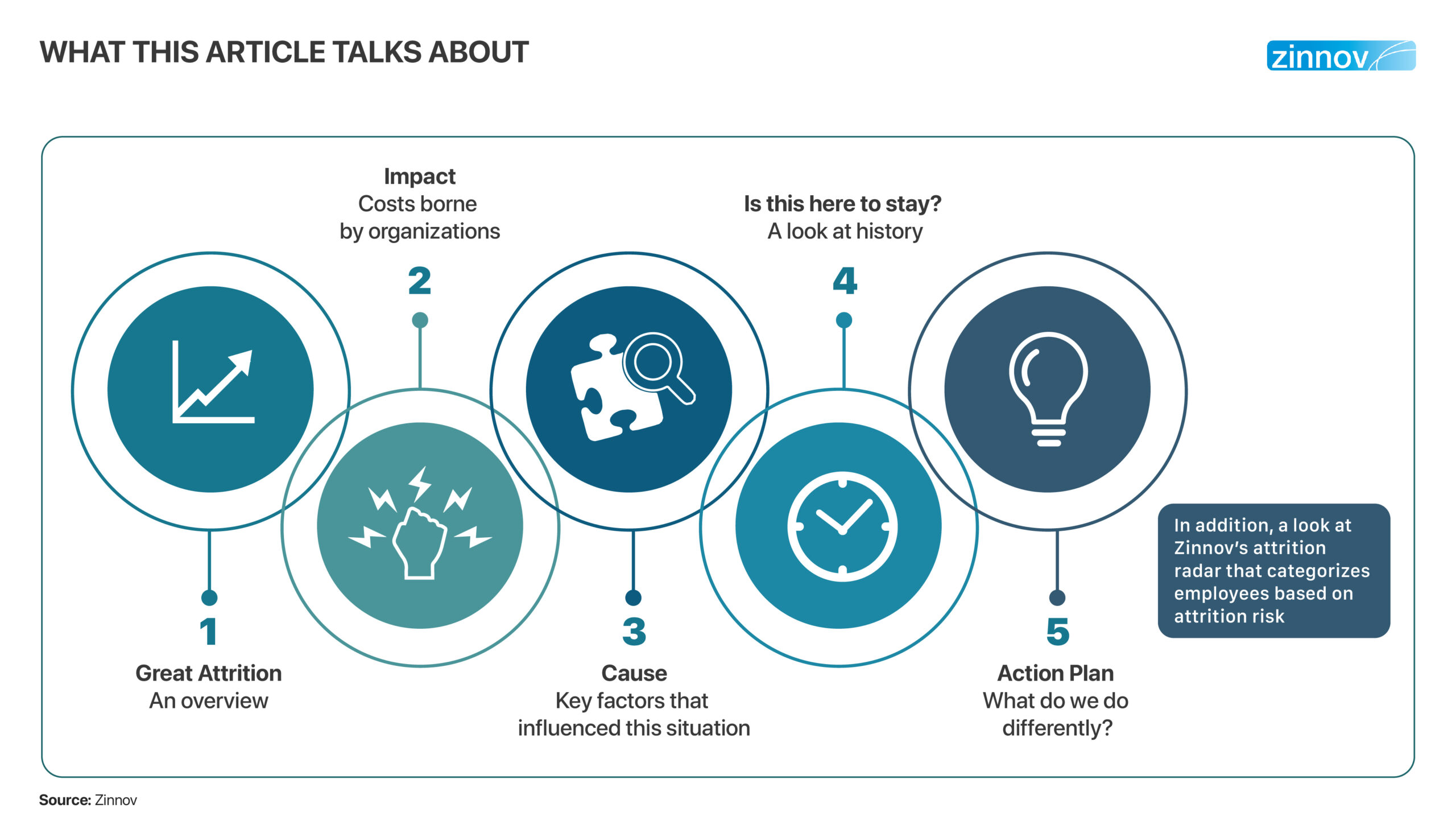
The situation in India quite mirrors the global scenario – providers reported a 50+% increase in attrition in the first half of 2021 as compared with last year. Cognizant reported[1] an attrition of 31% in their June 2021 quarter. Analysts predict an average attrition of 21-22% in IT/ITES industry throughout the year 2021.
In India, GCoEs (Global Centres of Excellence) set up by multinationals in India typically enjoy a relatively lower turnover ratio as compared with the overall IT/ITeS sector. However, this greater churn in the technology ecosystem was underscored by the findings of a recent study by Zinnov on Salary Increase, Attrition, and Hiring Trends among GCoEs. It found a sharp uptick in hiring, attrition, and salary in the first half of 2021, crossing pre-pandemic levels (refer figure below).
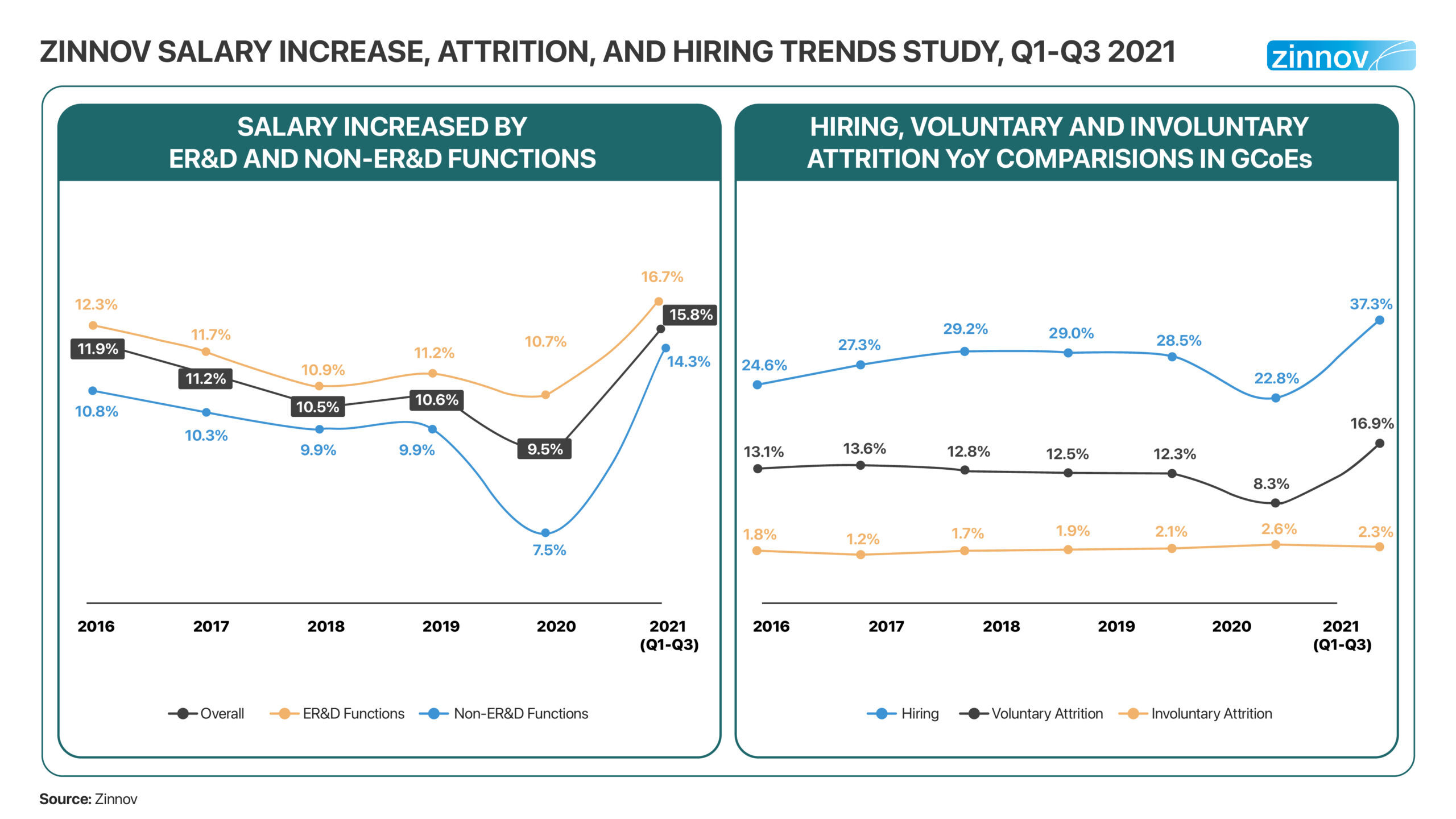
Companies are working in overdrive to stem the flow of skilled talent with expensive gifts, bumped up pay or attractive benefits. Its impact? Instead of cultivating loyalty among the employees, it is just pushing them to cash-in on the opportunity and enjoy some windfall gains. In such a situation, employees increasingly feel that they can ask for what they are worth, rather than be satisfied with what they are given.
While replacing an employee is a painful process due to notice periods and intense competition in the market, there are absolute cost impacts as well to the organization. An estimate cost of replacing an employee in a software product company is highlighted in the image below. The cost of replacing a software engineer in a product organization could range from 45-55% of the total annual remuneration based on staffing agency fees in the country, along with the cost of productivity loss. In fact, a 20% attrition rate in a 100-member organization in the US could translate into costs upwards of USD 1 Mn.
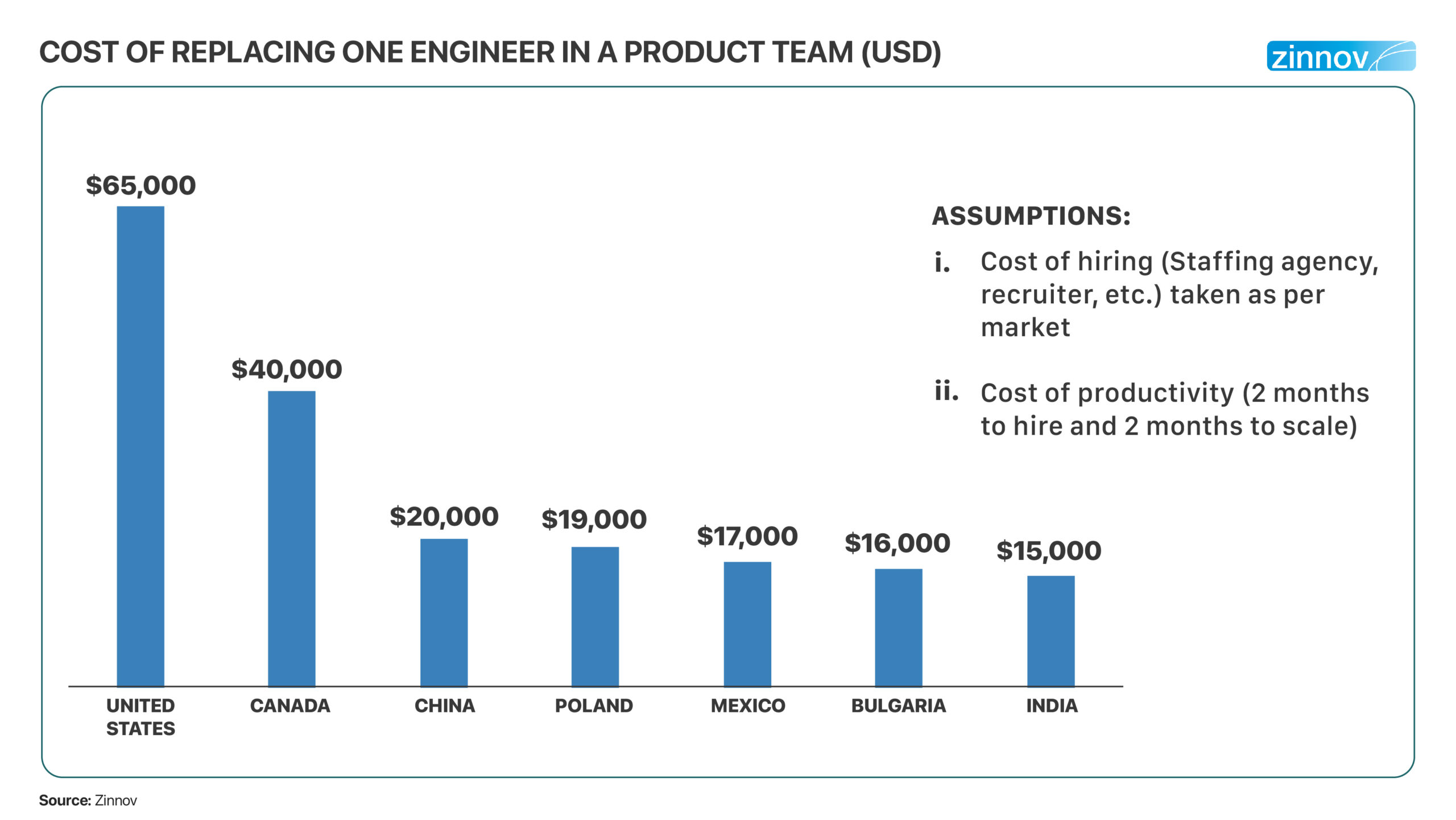
While the absolute costs are a cause for concern, there are far more intangible costs that the organizations must bear:
To solve and manage this situation, organizations need to understand the root cause of this tidal wave of attrition. There are two major factors that contribute towards this situation:
A) The Rapid K-shaped economic recovery fuelling growth, digitalization, and hence jobs
B) Working Environment
The COVID-19 pandemic wrecked economies across the world, bringing everything to a standstill. However, the recovery has been equally rapid, with governments announcing measures to boost consumption. Governments announced massive economic stimulus packages worth ~USD 16 Tn, and cut repo rates. These measures injected money into the system, while companies resorted to newer ways of doing business, and rapidly innovated to stay competitive in the new market reality. With the rollout of vaccines in early 2021, the market sentiments improved further.
The pandemic has made digitalization essential and forced global companies to explore digital solutions for everyday situations. 300 Mn people started working from home for the first time when COVID hit. About 80% of the students across India could not move to online education due to lack of access to the Internet. Almost overnight, brick and mortar stores were forced to add digital channels for shopping, giving a boost to digital platforms. For e.g., in a country like India, which has about 88% of its retail market attributed as the unorganized sector, platforms/apps made significant inroads. BigBasket, an app for buying groceries in India, saw an 84% increase in new customers in the first 6 months of 2020.
This trend of increased spend on digitalization is true across verticals. Zinnov’s 2021 Engineering R&D study reveals that organizations’ spend on Digital Engineering will grow at a rate of 19% over the next 2-3 years, primarily driven by the Software & Internet and BFSI verticals.
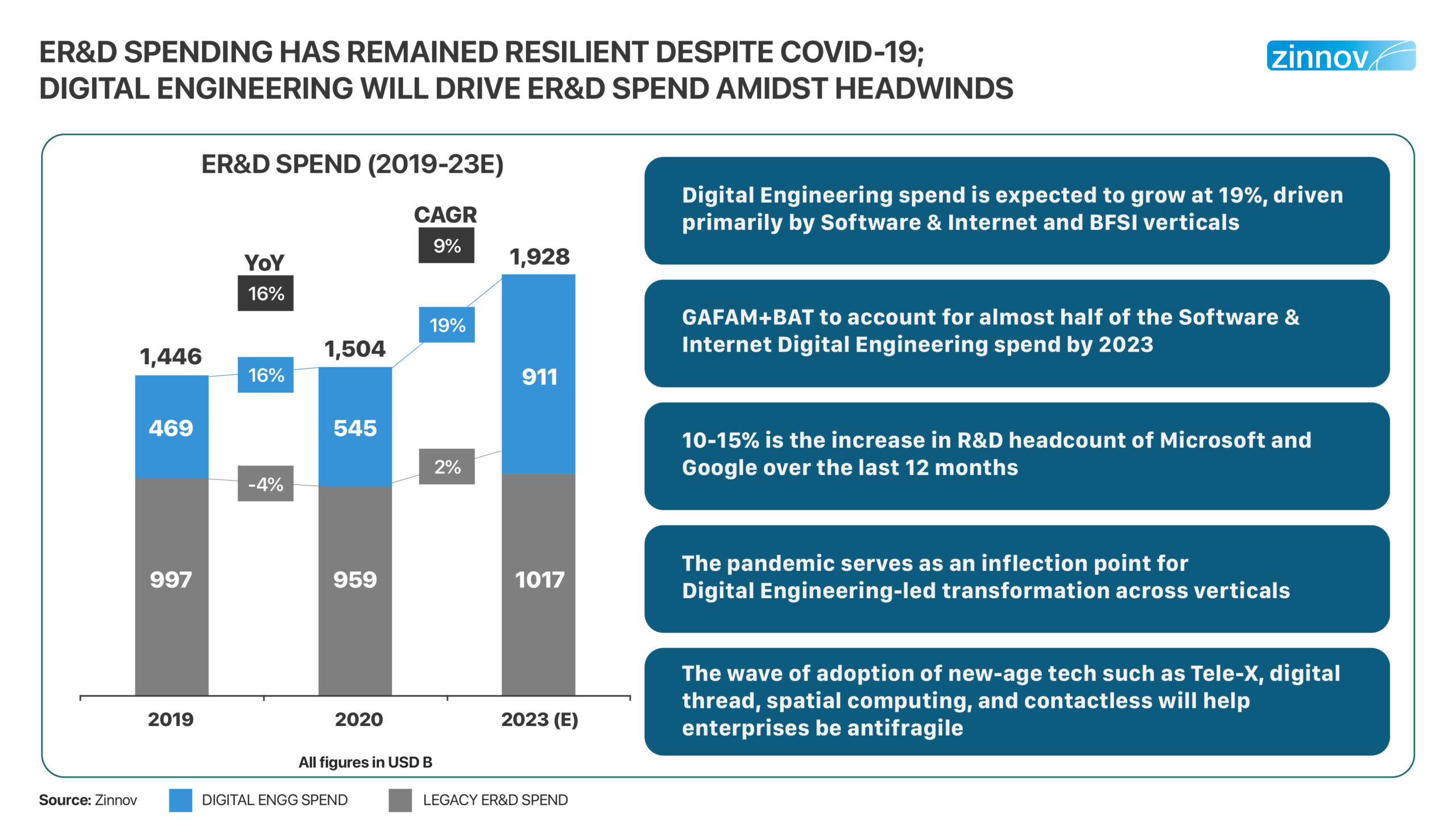
While the increased ER&D spend has increased opportunities for talent to choose from, the underlying stress from the new working environment has influenced many employees to exit their organizations. Some of the reasons include:
With hybrid work models becoming increasingly normal, companies are eager to lap up talent from geographies that were hitherto never considered. Companies including the FAANG (Facebook, Apple, Amazon, Netflix, and Google) are considering hiring up to 25% of their talent with flexibility to work from any location. Consequently, this has shot up attrition for tech companies in smaller towns across the globe, that cannot offer similar perks and benefits to their talent. In fact, tech companies in Portland, USA have already been reporting losing out tech talent[2] to Bay Area companies that offer Bay Area salaries – which are difficult for them to match.
Organizations witnessed higher productivity with their remote workforce (~120-130% increase) during the early days of COVID. However, this came at the cost of severe burnout. A Microsoft analysis revealed that an average MS Teams user sends 42% more chats per person after hours and has 62% more unplanned meetings. Productivity and growth without considering employee well-being is not sustainable and will only provide short-lived gains.
According to a study published in the Harvard Business Review[3], two-thirds of remote workers are not engaged and over a third never get to interact with their teams.
With so much change happening in such a compact timeframe across the world, employees are relooking at their personal priorities and careers. A host of pandemic-related struggles, coupled with the emergence of new opportunities, is expected to cause people to explore new roles.
The ongoing phenomenon is not new. Historically, when the world faced similar crises, we saw the market overcompensate temporarily for 1-2 years after the crisis, and then normalize. The growth and fall in trends for attrition, pay increase, and job growth are analogous to each other, especially after a financial crisis. All three factors go down during the crisis, followed by an overcompensation over the next 1-2 years, and eventually normalizing into a steady state. Case in point is the impact of the 2008 global financial crisis on attrition among leading IT/ITeS companies.
CASE STUDY – 2008 Global Financial Crisis
Post the 2008 financial crisis, major global IT Service Provider companies witnessed a sharp increase in attrition from about 10-12% in 2009 to 17-19% in 2010. However, it normalized to 11-12% by 2013.
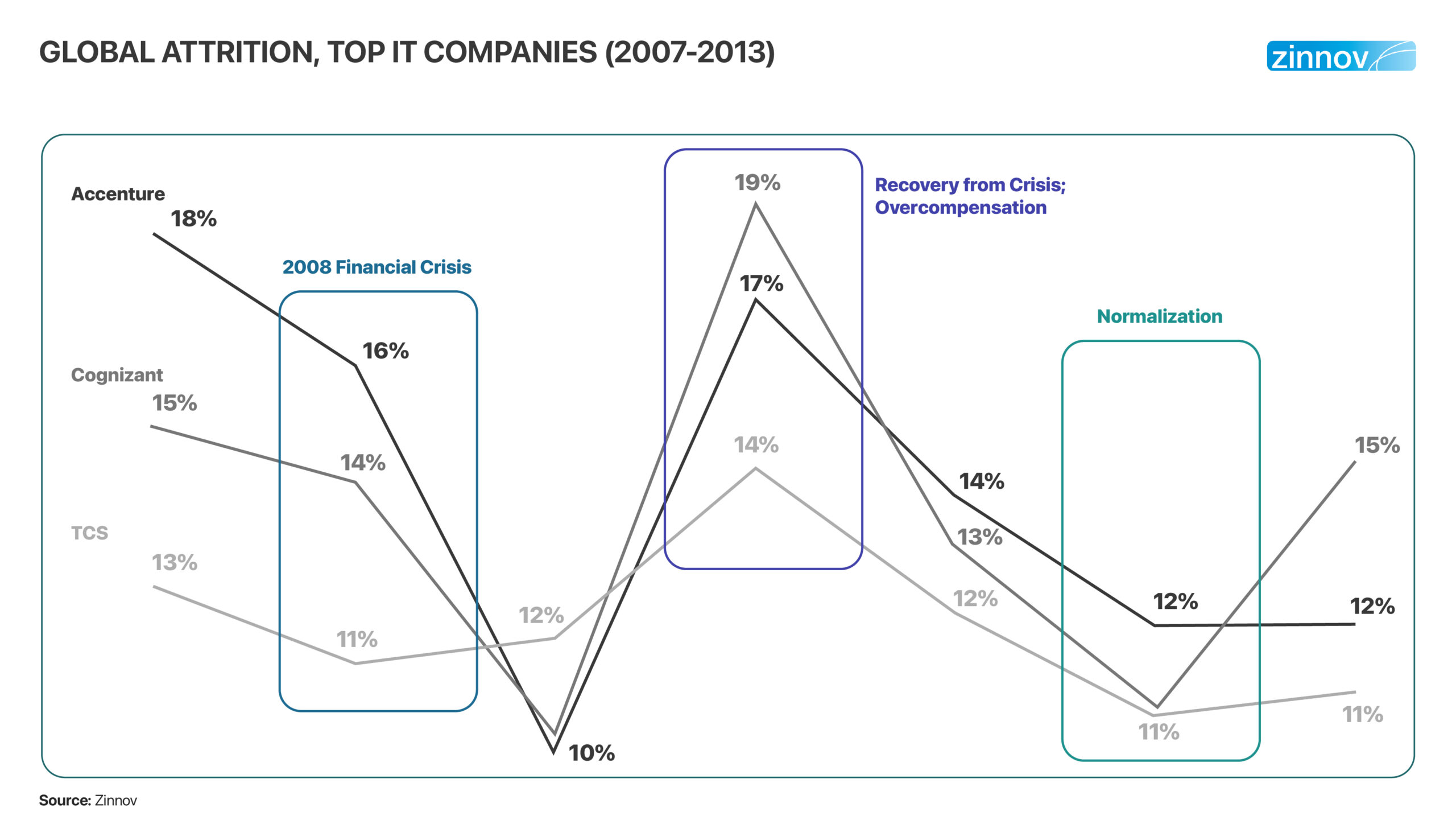
As has been observed in the period post the global financial crisis of 2008, the current attrition rates will normalize soon – but the question of when remains. Due to the lack of clarity on when the situation will normalize, organizations need to have an action plan for the time being and adapt to the changing market dynamics.
While attrition is a major issue plaguing the international job market, and one that does not have a clear end in sight, there are certain strategies that can mitigate the negative impact. While organizations and leaders should continue with the best practices that they have always followed, the current evolving situation demands that they look at things differently to adapt. There has never been one solution that fits the bill; rather companies should focus on doing multiple things right, that will eventually add up and result in improved employee retention, and potential talent attraction.
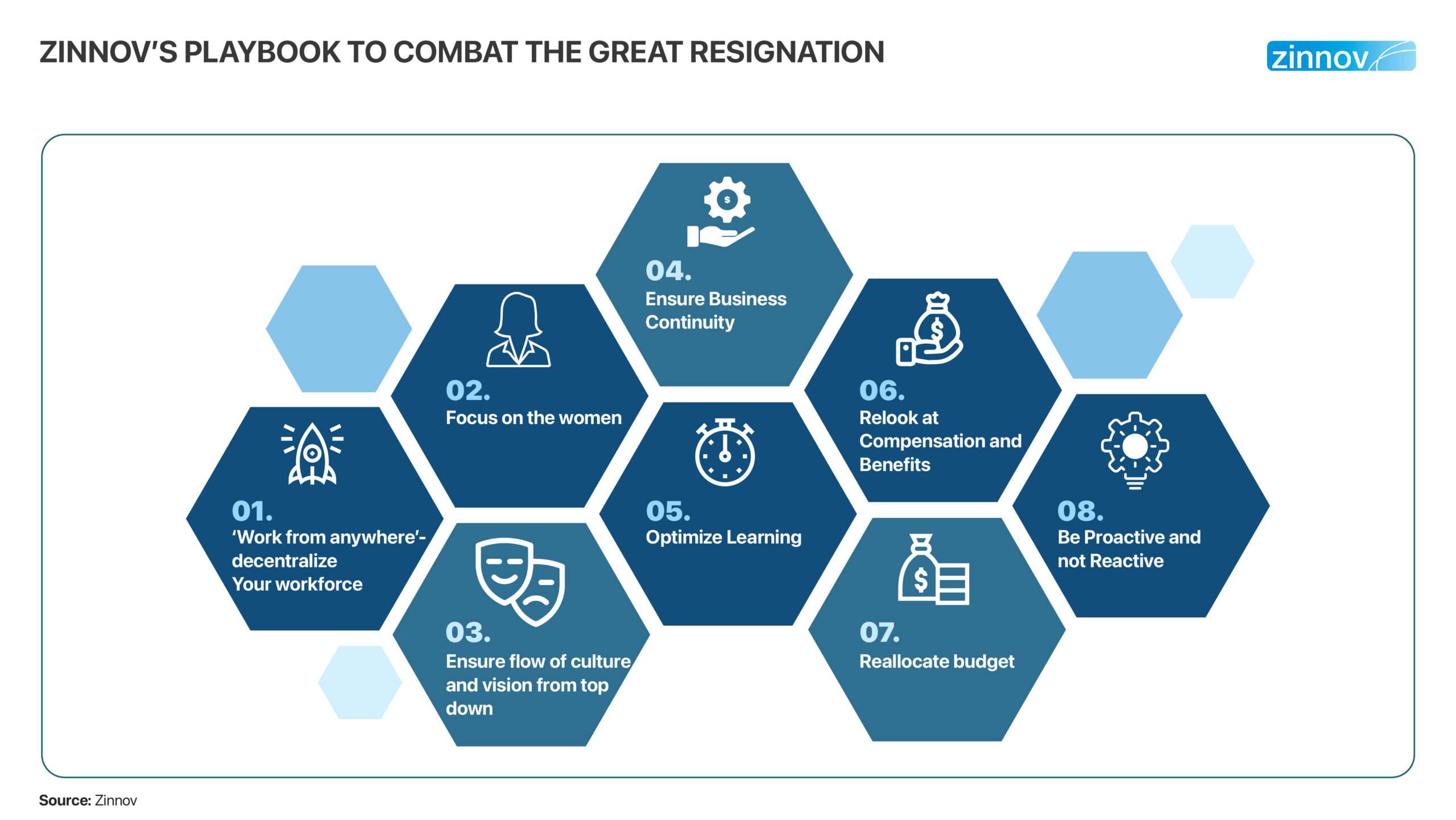
Organizations need to evaluate their team structures and roles and identify pockets of work that can be completely remote. A large segment of the talent pool increasingly prefers to work from home. Facilitating remote workforce will help companies target talent that was previously unavailable – every new job opening could be available to any capable individual irrespective of their location. Now that teams know they can work remotely, organizations can leverage globalization more effectively and manage costs better. This opportunity is being quickly lapped up by companies across the globe, as evidenced below.
In the US, Slack is moving towards the concept of smaller offices and co-working spaces spread across the country. As part of a pilot program, it has decided to give each of its full-time employees a membership to WeWork.
In India, HCL is running a “come back home” campaign, encouraging talent to work from their respective hometowns. As part of this, HCL hired thousands of engineers from emerging cities like Vijayawada, Nagpur, etc.
Companies can now start looking at remote talent that is spread across global hotspots.
2. Focus on the women
‘Work from anywhere’ opens up a completely untapped talent pool of women professionals who have had to leave their jobs for a multitude of reasons and obligations. With the flexibility offered from work from home, this is a pool that companies are increasingly targeting.
According to a survey by JobsForHer (a career platform exclusively for women in India), 65% of large enterprises have introduced special initiatives to bring women back into the workforce after a career break. In fact, the JobsForHer platform witnessed a 22% increase in work from home job opportunities exclusively for women in 2020.
Capgemini has announced that it is hiring women in tier-2 and -3 Indian cities to work remotely in its Cloud and Infrastructure Services (CIS) team through its ‘Sakhi Drishtikon’ initiative.
3. Ensure flow of culture and vision from top down
Working out of a physical office provides employees with the opportunity (especially new hires) to organically assimilate the organization’s culture, vision, and mission. In the world of remote work, this channel is completely cut off and the onus is on the leadership to make extra efforts to distill company vision and values through the company. There are many concerted methods to arrive at this – catch-up with the CEO for new employees, regular virtual social meet-ups and casual sync-ups, cross-team collaboration, etc. – are some of the avenues that companies are exploring. Companies need to keep telling their story to the employees at the risk of over-communication. In addition to this, transparency and empathy are traits that elicit trust in an organization.
For example, Intuit places a new employee in a ‘no-work zone’ for 30 days, and 100% of their time during this is towards learning the business and the culture. With extreme focus on culture and employee well-being among other things, they manage to keep their attrition below 7%.
4. Ensure Business Continuity
Never stop hiring – it has become essential to keep the hiring pipeline warm, especially in countries like India where the notice period during exit range upwards of 60 days. This ensures that organizations stay ahead of the curve. Zinnov customers under the GCoE Accelerator program keep their recruitment engine always running for a sample set of roles, and hence, are always better positioned to make quick offers in case of an attrition.
A remote buffer workforce in upcoming talent hotspots in the world is an option that organizations can explore to ensure business continuity. These teams can pick up ad hoc tasks, work on pilot projects, and also pick up slack in cases of attrition spike in global teams
5. Optimize Learning
Even before the current market dynamics set in, Learning & Development (L&D) has been a key lever in the gameplan for employee retention – 45% employees leave organizations due to lack of L&D opportunities according to a LinkedIn study [4]. In addition to the attrition problem, there is an estimated ~30% shortage of digital talent globally, and upskilling and reskilling are going to be key tools to combat this
Organizations should also take a build vs buy approach when in need of specific skillsets. Any new skillset that the organization needs should be cultivated within the orgafenization through upskilling rather than hiring fresh talent to fill that need – this empowers employees to take charge of their growth and improves retention.
In the current remote/hybrid world, the need is to further optimize learning to make it more impactful. Companies need to adapt a fully digital learning ecosystem and promote brownbag sessions that help both knowledge sharers and learners. It also needs programs that are more essential nowadays such as empathy training for managers, training on remote collaboration, leadership programs for remote teams, open innovation in remote teams, etc.
6. Relook at Compensation and Benefits
Compensation ranges need to be relooked at since the market has seen an overhaul in the past one year. Zinnov research in software product recruiting in India saw midpoints shifting at a considerable 30-40% for certain roles. To address this, relooking at the compensation is important; however, it is becoming more important to relook at the value offered as part of total rewards and not just compensation in isolation.
The benefits as part of the total rewards must be relooked at as well, to make them more suitable for a remote-friendly workforce. Companies are reallocating budgets for gyms, food coupons, team outings, etc., towards well-being programs (telemedicine, counselling services, etc.), L&D programs for professional development, etc.
7. Reallocate budget
There is an imminent need to reorganize and reallocate budget and policies in the post-pandemic era. For example, opening a brand-new office for 1000 employees might not make sense with an increasingly hybrid scenario. Rather, organizations can look at having micro-offices, i.e., 50–100-seater collaboration spaces spread across multiple locations to enable those in-person meetings and learning through osmosis.
Essentially, organizations need to cut down on legacy items that do not make the most sense in today’s world and redirect it towards initiatives to comply with the evolving new normal.
8. Be Proactive and not Reactive
All the efforts towards retention should not start when employees start resigning; rather organizations should focus on building an early warning system that will catch potential at-risk employees. This translates into more connects, managers going deeper in one-to-one meetings, pulse checks, relook at the growth trajectory of employees, and adjust goal setting if necessary, etc.
In essence, the goal is to make sure the attrition is not a surprise for the organization. To monitor at-risk talent, Zinnov has a proprietary framework – the Zinnov Attrition Radar.
Zinnov’s Attrition Radar Framework: Zinnov’s proprietary framework enables managers or company leadership to segregate talent into various buckets based on risk of attrition. The framework looks at various metrics around performance management, compensation parity, employee engagement, current project, etc., to arrive at a weighted score outlining attrition risk.
The framework can give organizations insights and answers to questions such as the rate of their total talent that is at high risk, and the focus areas that need to be worked on.
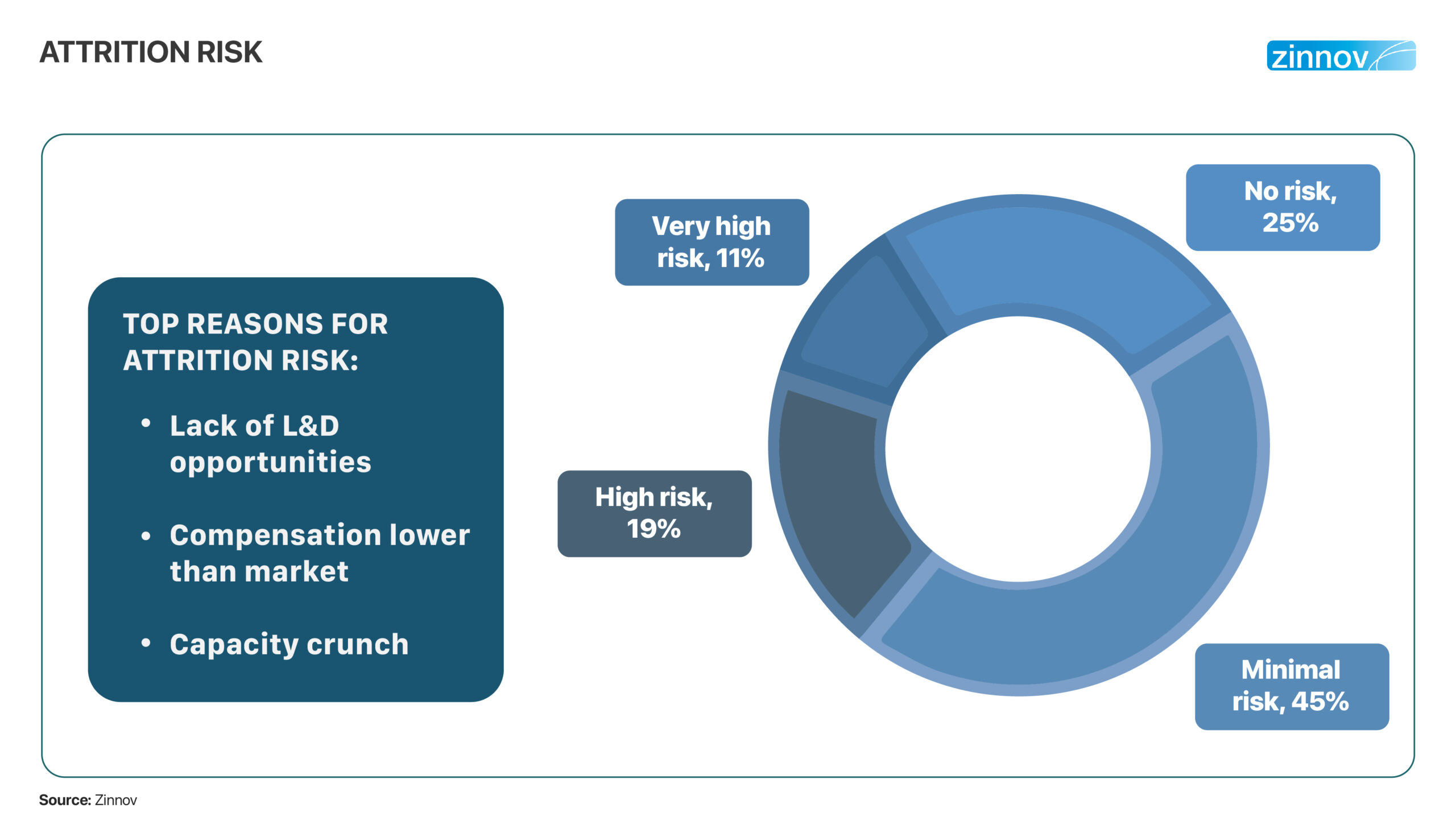
A multitude of factors have contributed to what the world is commonly calling ‘The Great Attrition.’ While history teaches us that such turbulent situations will eventually subside and normalize, these unprecedented times brought on by COVID are sure to leave some lasting effects in the way we work, the expectations from the employees and the workplace itself. Remote work is here to stay in some form or the other, for the foreseeable future. Organization needs to look inwards with a magnifying lens, identify the underlying reasons within the organization that are contributing to the Great Resignation, and deploy mitigation strategies to stem the flow of talent, while also attracting new talent. With careful planning, and optimization of certain key processes and policies, organizations can come out ahead of this ongoing phenomenon.